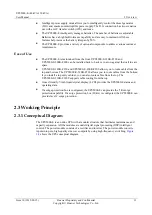
UPS5000-E-(40 kVA-320 kVA)
User Manual
2 Overview
Issue 10 (2015-09-15)
Huawei Proprietary and Confidential
Copyright © Huawei Technologies Co., Ltd.
27
Table 2-5
Typical configurations
Function
Application Scenario
Single UPS
A single UPS5000-E is applicable to scenarios with light loads. Its
power will be redundant when loads are light as it adopts modular
design.
N+X parallel system,
where N is the
number of requisite
UPSs connected in
parallel, and X is the
number of redundant
UPSs
An N+X parallel system supplies power to important loads in
small- and medium-sized equipment rooms. It features high
reliability and powerful transient overload capacity.
1 ≤ N+X ≤ 4 (1 ≤ N ≤ 4, 0 ≤ X ≤ 3)
For example, in a 3+1 parallel system, three UPSs are requisite
UPSs and one UPS is redundant.
Dual-bus system
The dual-bus system is suitable for scenarios where highly
reliable power supply is required. The dual-bus system supplies
power to important loads in large- and medium-sized equipment
rooms and data centers. The dual-bus system is highly reliable,
but its configuration is complex.
A 1+1 parallel system is a typical configuration. You can set the number of requisite UPSs and
redundant ones on the LCD and WebUI.
2.5.1 Single UPS
The UPS5000-E has a modular structure. Its power modules are connected in parallel to
deliver a high loading capability. If a single power module develops a fault, the other power
modules continue working. So long as the load is not too large, this redundant capacity can
continue to provide power and therefore helps ensure reliability.
conceptual diagram of a single UPS.
2.5.2 N+X Parallel System
In an N+X parallel system, multiple UPS5000-Es are connected together. Specifically, mains
input, bypass input, and output terminals are connected in parallel, and ECMs are connected
over parallel cables. The parallel connections synchronize the UPS outputs to supply power to
loads. If a single UPS fails, the other UPSs continue supplying power to loads.
shows the conceptual diagram of an N+X parallel system.
















































